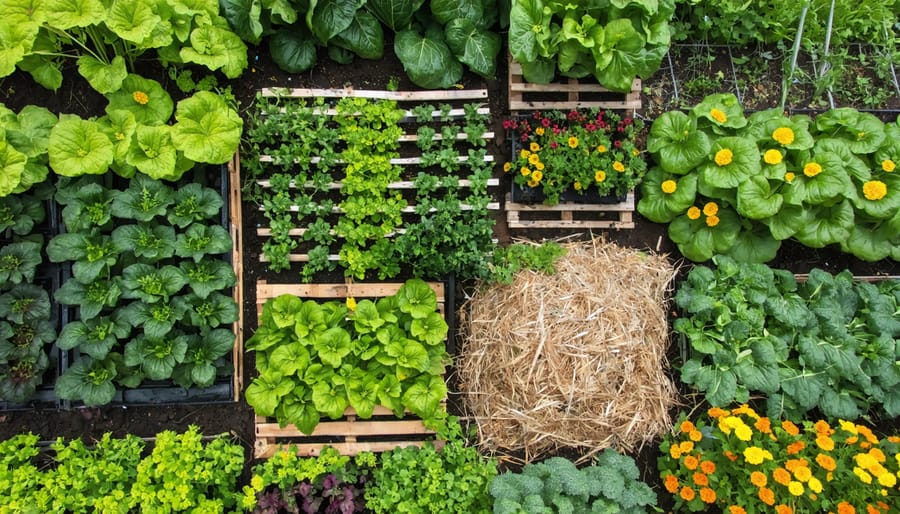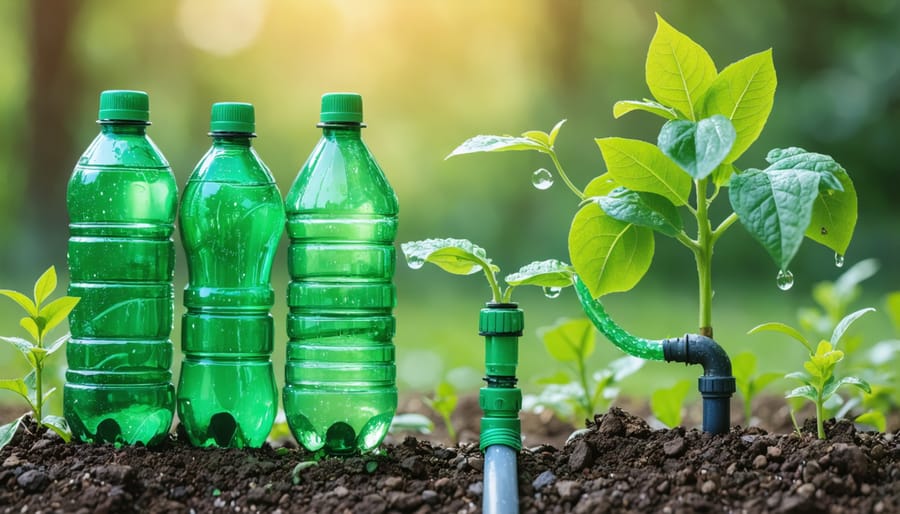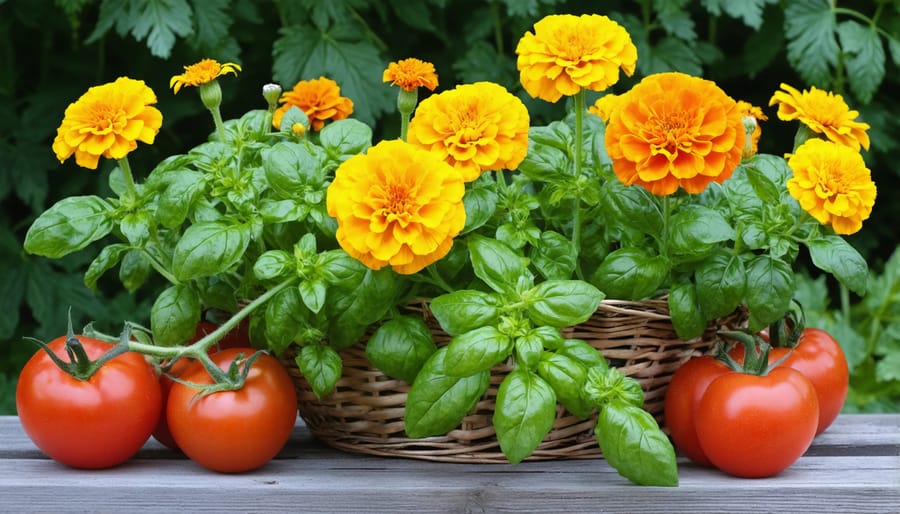These Frugal Garden Tricks Double Your Vegetable Harvest (Without Chemicals)

Transform your vegetable garden into a thriving oasis by repurposing cardboard as natural weed barriers, slashing water usage by 60% through deep mulching with straw, and boosting yields using companion planting strategies. Maximize limited space with vertical growing systems made from recycled gutters and pallets, while implementing eco-friendly gardening solutions like homemade compost tea fertilizer. Combat common pests naturally by interplanting marigolds and nasturtiums throughout your beds, creating a robust ecosystem that protects your crops without harmful chemicals. These time-tested techniques not only reduce maintenance costs but also ensure a bountiful harvest of nutrient-rich vegetables throughout the growing season.
Smart Composting Secrets That Cost Nothing
Kitchen Scraps Gold Mine
Transform your kitchen waste into gardening gold with a well-managed compost system. Start by collecting vegetable scraps, coffee grounds, eggshells, and fruit peels in a dedicated container. Layer these “green” materials with “brown” materials like dried leaves, newspaper, and cardboard to create the perfect balance for decomposition.
Keep your compost pile moist but not soggy, and turn it regularly with a garden fork to ensure proper aeration. Coffee grounds are particularly valuable, as they add nitrogen and improve soil structure. Crushed eggshells provide calcium and help prevent blossom-end rot in tomatoes and peppers.
Avoid adding meat, dairy, or oily foods to your pile, as these can attract pests and slow down decomposition. Instead, focus on fruit and vegetable scraps, which break down quickly and provide essential nutrients. For faster results, chop larger scraps into smaller pieces before adding them to your pile.
Your finished compost should be dark, crumbly, and smell earthy – perfect for mixing into your vegetable garden soil or using as a nutrient-rich top dressing.

Leaf Mold Magic
Transform your fallen autumn leaves into gardening gold with this simple yet effective composting technique. Instead of bagging and disposing of leaves, create leaf mold – a dark, rich soil conditioner that your vegetable garden will love. Simply collect dry leaves, shred them if possible (running over them with a lawn mower works great), and pile them in a corner of your yard or in a wire bin. Keep the pile moist but not waterlogged, and let nature do its work.
After about 6-12 months, you’ll have a crumbly, sweet-smelling amendment that improves soil structure, retains moisture, and provides essential nutrients for your vegetables. For faster decomposition, add a sprinkle of soil or finished compost to introduce beneficial microorganisms. Use leaf mold as a mulch around your plants or mix it into your garden beds before planting.
This zero-cost solution not only helps your garden thrive but also reduces waste and supports a sustainable gardening practice. Pro tip: Oak and beech leaves make particularly nutrient-rich leaf mold, though any deciduous leaves will work well.
Water-Wise Solutions for Penny-Pinchers

DIY Drip Systems
Creating your own DIY drip irrigation system doesn’t have to break the bank. By repurposing everyday items, you can build efficient water collection systems that keep your vegetables thriving while saving money and resources.
Start with clean plastic bottles or milk jugs – these make perfect slow-release watering devices. Simply punch small holes in the caps and sides, then bury them next to your plants with the openings facing the roots. For larger garden beds, connect several plastic bottles using old garden hoses cut into sections, creating a network of water channels.
Another clever solution involves using PVC pipes with drilled holes, positioned strategically throughout your garden. Cap the ends and connect them to a main water source – this creates an even distribution of water to all your plants. For container gardens, try threading cotton rope through the drainage holes, with one end in a water reservoir below. This creates a self-watering system using capillary action.
Remember to position your DIY drip systems slightly below soil level to prevent evaporation and protect the materials from sun damage. These simple solutions not only conserve water but also ensure your vegetables receive consistent moisture – essential for healthy growth and abundant harvests.
Mulching with Free Materials
One of the smartest ways to repurpose household materials is by using them as mulch in your vegetable garden. Start by laying down newspaper or cardboard around your plants, making sure to overlap the edges to prevent weeds from sneaking through. These materials naturally break down over time while keeping moisture in and weeds out.
Look around your neighborhood for free mulching materials. Fall leaves, grass clippings, and pine needles make excellent mulch and are often available for free. Just be sure the grass hasn’t been treated with chemicals. You can also ask local coffee shops for used coffee grounds – they’re fantastic for moisture retention and add nutrients to the soil.
For larger gardens, check with local tree services about getting free wood chips. Many companies are happy to drop off a load rather than pay dumping fees. These chips work wonderfully for pathways between garden beds and gradually decompose to enrich your soil.
Layer your mulch about 2-3 inches thick, keeping it slightly away from plant stems to prevent rot. This simple technique can cut your watering needs by up to 50% while improving soil health naturally.
Natural Pest Control That Actually Works
Companion Planting Pairs
Nature’s best gardening secret lies in strategic plant partnerships that work together to create a thriving vegetable garden. By pairing compatible plants, you can naturally deter pests while maximizing your growing space and improving crop yields.
Tomatoes and basil are classic companions – the basil enhances tomato flavor while repelling flies and mosquitoes. Plant marigolds throughout your garden beds; these cheerful flowers naturally ward off harmful nematodes and attract pollinators. Carrots and onions make perfect partners, as onions’ strong scent masks the smell that typically attracts carrot flies.
Plant nasturtiums near your cucumbers and squash to deter aphids and other soft-bodied insects. The bright flowers also serve as a trap crop, drawing pests away from your valuable vegetables. Combine beans with corn and squash to create the traditional “Three Sisters” garden – the corn provides support for climbing beans, while squash spreads along the ground to suppress weeds.
For natural pest control, surround your cabbage family vegetables with aromatic herbs like dill, sage, and rosemary. These herbs confuse and repel cabbage moths and other destructive insects. Remember to intersperse flowers like zinnias and cosmos throughout your vegetable beds to attract beneficial insects that help control pest populations naturally.

DIY Natural Sprays
Save money and protect your garden naturally with these effective DIY spray solutions using common household ingredients. Mix one tablespoon of neem oil with a teaspoon of liquid soap and a quart of water for a powerful pest deterrent that won’t harm beneficial insects. For fungal issues, combine equal parts milk and water to create a spray that prevents powdery mildew, especially effective on squash and cucumber plants.
Combat aphids and other soft-bodied pests by mixing two tablespoons of dish soap with a quart of water. For an extra boost, add a few drops of peppermint essential oil, which naturally repels many garden pests while making your garden smell fresh. To deter larger pests like rabbits and deer, blend three raw eggs with a cup of water and strain the mixture – this natural spray creates an unpleasant smell that keeps critters away.
For a quick calcium boost, save your eggshells, crush them finely, and soak in water overnight. This calcium-rich spray works wonders for tomatoes and peppers, helping prevent blossom end rot. Another kitchen hero is garlic – blend several cloves with water and strain to create a natural fungicide and insect repellent that’s particularly effective for protecting leafy greens.
Remember to reapply these natural solutions after rain and test on a small area first to ensure plant safety.
Space-Maximizing Techniques
When space is at a premium, getting creative with your vegetable garden layout can dramatically increase your yield. Vertical gardening is a game-changer – try installing trellises for climbing vegetables like peas, cucumbers, and pole beans. These plants grow upward instead of sprawling across precious ground space.
Make the most of every inch by implementing square foot gardening techniques. Divide your garden bed into 1×1 foot squares and plant different vegetables in each section based on their spacing needs. This method can yield up to four times more produce than traditional row planting.
Consider companion planting to maximize both space and plant health. Pair tall plants with shorter ones that thrive in partial shade. For example, plant lettuce beneath tomatoes or grow radishes between rows of slower-growing carrots.
Hanging gardens are perfect for small spaces. Use hanging baskets for cherry tomatoes, strawberries, and herbs. Install gutters along fences or walls to create channels for growing shallow-rooted vegetables like lettuce and spinach.
Don’t overlook container gardening – even five-gallon buckets can produce impressive yields. Stack containers vertically using tiered stands or create a tower garden using PVC pipes with holes cut for plants. Remember to ensure adequate drainage and use quality potting soil for best results.
By implementing these eco-friendly garden hacks, you’ll not only save money but also create a thriving, sustainable vegetable garden that works in harmony with nature. From water-wise solutions to natural pest control methods, these approaches help reduce your environmental impact while maximizing your harvest. Remember, every small change makes a difference – whether it’s starting a compost pile, incorporating companion planting, or using recycled materials for garden structures. Start with one or two techniques that resonate with you, and gradually expand your eco-friendly practices as you become more comfortable. Your garden will reward you with healthier produce, lower maintenance costs, and the satisfaction of knowing you’re contributing to a greener future. Why not get started today and watch your garden transform into an efficient, sustainable ecosystem?

